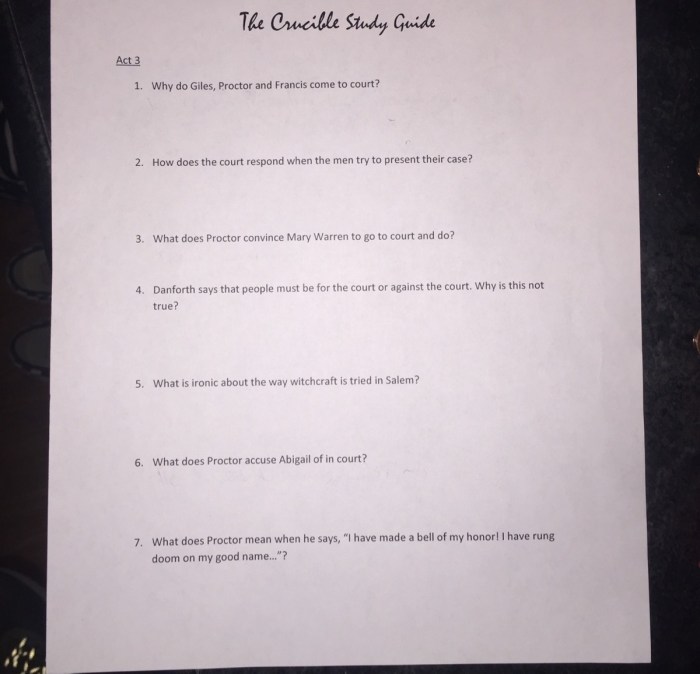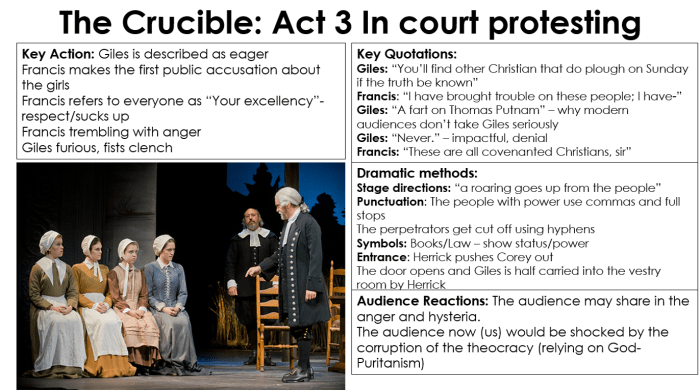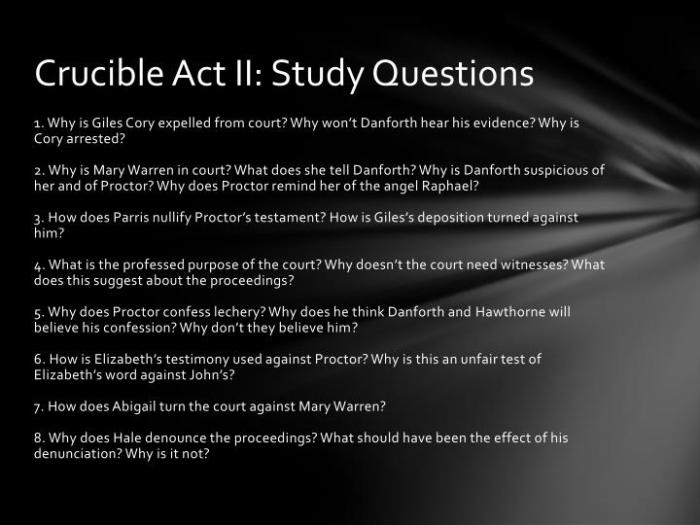Act 4 study guide the crucible – Act 4 of “The Crucible” captivates readers with its gripping plot developments, profound character interactions, and potent themes. This study guide will delve into the intricacies of the play’s fourth act, offering insights and analysis to enhance your understanding and appreciation.
Character Analysis

The Crucible delves into the complex motivations and actions of several characters, each playing a pivotal role in the unfolding drama of the witch trials. Three central figures stand out in this regard: Abigail Williams, John Proctor, and Reverend Parris.
Abigail Williams
Abigail, a young and ambitious servant girl, is driven by a desire for power and vengeance. Her unrequited love for John Proctor fuels her malicious accusations against innocent villagers, seeking to eliminate any obstacles to her desired relationship.
John Proctor
John Proctor emerges as a morally conflicted character. Initially reluctant to speak out against the accusations, he eventually finds his conscience and courage to confront the hysteria and injustice surrounding him. His struggle between personal integrity and the preservation of his family reflects the moral complexities of the play.
Reverend Parris
Reverend Parris, the minister of Salem, is motivated by a desire to maintain his authority and reputation within the community. His self-serving actions, such as concealing his daughter’s involvement in witchcraft, contribute to the escalating tensions and divisions in the town.
Themes and Symbolism
Act 4 of The Crucibledelves into profound themes and employs potent symbolism to convey its central messages.
The Crucible as a Symbol, Act 4 study guide the crucible
The crucible, a device used to purify metals, serves as a powerful symbol in the play. It represents the trials and tribulations that the characters endure in their pursuit of justice and redemption. Just as the crucible purifies metals by removing impurities, the trials faced by the characters reveal their true nature and expose their flaws.
If you’re studying Act 4 of The Crucible, you might also be interested in the script for The Little Mermaid Jr. This musical adaptation of the classic Disney film features memorable songs and characters, making it a great choice for students who enjoy theater and music.
While the two works are quite different in terms of subject matter, they both explore themes of love, loss, and redemption. So, if you’re looking for a fun and engaging way to learn more about Act 4 of The Crucible, be sure to check out The Little Mermaid Jr.
script.
Witchcraft as a Metaphor
The accusations of witchcraft in The Crucibleserve as a metaphor for the persecution and scapegoating of innocent individuals. The witch hunt represents the dangers of mass hysteria and the ease with which fear and prejudice can lead to injustice. By accusing others of witchcraft, the characters are projecting their own fears and insecurities onto others, creating a cycle of violence and retribution.
Plot Development
Act 4 of The Crucible marks a turning point in the play’s plot. It is here that the climax and falling action of the story occur, leading to the play’s tragic conclusion.
Rising Action
The rising action of Act 4 centers around the court proceedings. The accusations against the accused witches reach their peak, with Giles Corey being pressed to death for refusing to enter a plea. The tension and fear in the community escalate as more and more people are accused and imprisoned.
Climax
The climax of the act occurs when John Proctor confesses to Abigail’s false accusations. However, his confession is not enough to save him or the others who have been accused. The court, blinded by religious fervor and the desire for power, condemns Proctor and the others to death.
Role of the Court Proceedings
The court proceedings play a crucial role in the plot of Act 4. They serve as the setting for the climax of the play and the ultimate resolution of the conflict between the accused witches and the community. The court’s decisions have a profound impact on the lives of the characters and the fate of the community as a whole.
Style and Language: Act 4 Study Guide The Crucible

In Act 4, the language used is stark and concise, reflecting the desperation and tension of the characters.
The dialogue reveals character and conflict through its use of short, sharp sentences and terse exchanges. The characters speak in a clipped, almost mechanical manner, reflecting their emotional exhaustion and the weight of the situation they find themselves in.
Stage Directions
The stage directions in Act 4 are sparse but highly effective. They create a sense of atmosphere and tension, and they help to build the suspense of the play.
- For example, the stage directions at the beginning of the act indicate that the room is “dark and empty.” This creates a sense of foreboding and isolation, and it foreshadows the events that are about to unfold.
- Later in the act, the stage directions indicate that the characters are “speaking in low voices.” This creates a sense of secrecy and intimacy, and it suggests that the characters are afraid to be overheard.
Historical Context

The Salem witch trials, which took place in colonial Massachusetts in 1692, serve as the historical backdrop for Arthur Miller’s “The Crucible.” The play delves into the mass hysteria and social turmoil that engulfed the community during this period.
Role of Superstition and Fear
Superstition and fear played a pivotal role in the Salem witch trials. The Puritans, who held strong religious beliefs, were deeply suspicious of anything that deviated from their strict moral code. Accusations of witchcraft provided an outlet for their fears and anxieties about the unknown.
- Superstitious Beliefs:The Puritans believed in the literal existence of witches and the Devil, making them vulnerable to accusations of witchcraft based on seemingly innocuous behavior.
- Social Tensions:Salem was a divided community, with tensions between different factions. Accusations of witchcraft became a way to settle scores and gain power.
- Fear of the Unknown:The Puritans lived in a harsh and unforgiving environment, where disease and death were common. Witchcraft provided a scapegoat for their fears and insecurities.
Relevance to Modern Society
“The Crucible” remains relevant to modern society as it explores themes of mass hysteria, the dangers of intolerance, and the importance of individual conscience.
- Mass Hysteria:The play highlights the dangers of mass hysteria, where irrational beliefs and fear can lead to persecution and injustice.
- Intolerance:“The Crucible” condemns the intolerance and prejudice that can divide communities and destroy lives.
- Individual Conscience:The play emphasizes the importance of standing up for one’s beliefs, even in the face of adversity.
Clarifying Questions
What is the significance of the crucible in Act 4?
The crucible represents the trials and tribulations that the characters face, both physically and emotionally. It symbolizes the intense heat and pressure that force them to confront their inner selves and make difficult choices.
How does John Proctor’s character develop in Act 4?
In Act 4, Proctor grapples with the consequences of his actions and the moral dilemmas he faces. He struggles to maintain his integrity while also trying to protect his loved ones. His character undergoes a profound transformation as he confronts his own mortality and the complexities of justice.
What are the major themes explored in Act 4?
Act 4 explores themes of guilt, redemption, and the dangers of mass hysteria. The characters grapple with their past actions and the consequences they must face. The play also examines the role of superstition and fear in driving people to commit heinous acts.